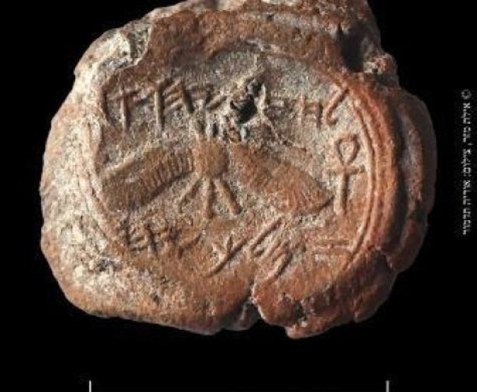The BBC has finally caught up with the news that a seal of King Hezekiah has been found by Israeli archaeologists.
 At www.jewishpress.com/news/breaking-news/king-hezekiahs-seal-discovered-in…… and at http://archaeologynewsnetwork.blogspot.co.uk/2015/12/seal-bearing-name-o… … excavations at the Hebrew University (grounds) in Jerusalem, on Mount Ophel and at the foot of the southern wall of the Temple Mount, have turned up trumps – a seal of King Hezekiah in a dateable context. He reigned between 727-698BC and therefore this discovery validates the general scope of Biblical history during the Monarchy – making a mockery of the minimalist position.
At www.jewishpress.com/news/breaking-news/king-hezekiahs-seal-discovered-in…… and at http://archaeologynewsnetwork.blogspot.co.uk/2015/12/seal-bearing-name-o… … excavations at the Hebrew University (grounds) in Jerusalem, on Mount Ophel and at the foot of the southern wall of the Temple Mount, have turned up trumps – a seal of King Hezekiah in a dateable context. He reigned between 727-698BC and therefore this discovery validates the general scope of Biblical history during the Monarchy – making a mockery of the minimalist position.
Seals or stamps were used to sign documents written on papyrus and kept rolled and tied with twine. It was discovered together with many sherds of pottery (and various other objects) in what was a rubbish dump. Unfortunately that is not strictly a stratagraphical position as a rubbish dump is indicative rather than in situ evidence. The good news is that the rubbish dump was associated with a specific building amongst a specific group of buildings and it is therefore chronologically significant (as long as it is backed up by other finds). These buildings, according to one archaeologist, Eilat Mazar, date from the time of Solomon and she is apparently suggesting they were in use right down to the time of Hezekiah. At this point we are in the middle of the Israeli chronological dispute between Finkelstein and the more traditional archaeologists who see Iron Age IIA as Solomonic (whereas Finkelstein generally dates Iron IIA to the 9th century). One can see immediately an opening for revised chronological schemes as it would be more sensible, perhaps, to see the buildings as essentially 8th century BC, falling into disrepair shortly after the reign of Hezekiah as a result of the Assyrian absorption of Judah into the greater empire.
The seal has the inscription, 'Hezekiah (son) Ahaz king of Judah' together with an emblem of a sun disc with wings and an icon of the 'ankh' – indicating Egyptian influence. Hezekiah was aligned with the Egyptians and opposed to Sennacherib, even though the latter campaigned extensively in Philistia and the Levant. Other seals of Hezekiah have appeared on the black market with the symbol of a winged scarab (dung beetle) another Egyptian motif, and others with winged sun symbols (possibly cometary in nature). Hezekiah is reputed to have campaigned in the land of the Philistines which may indicate he actually took part in the Egyptian coalition against Assyria.
